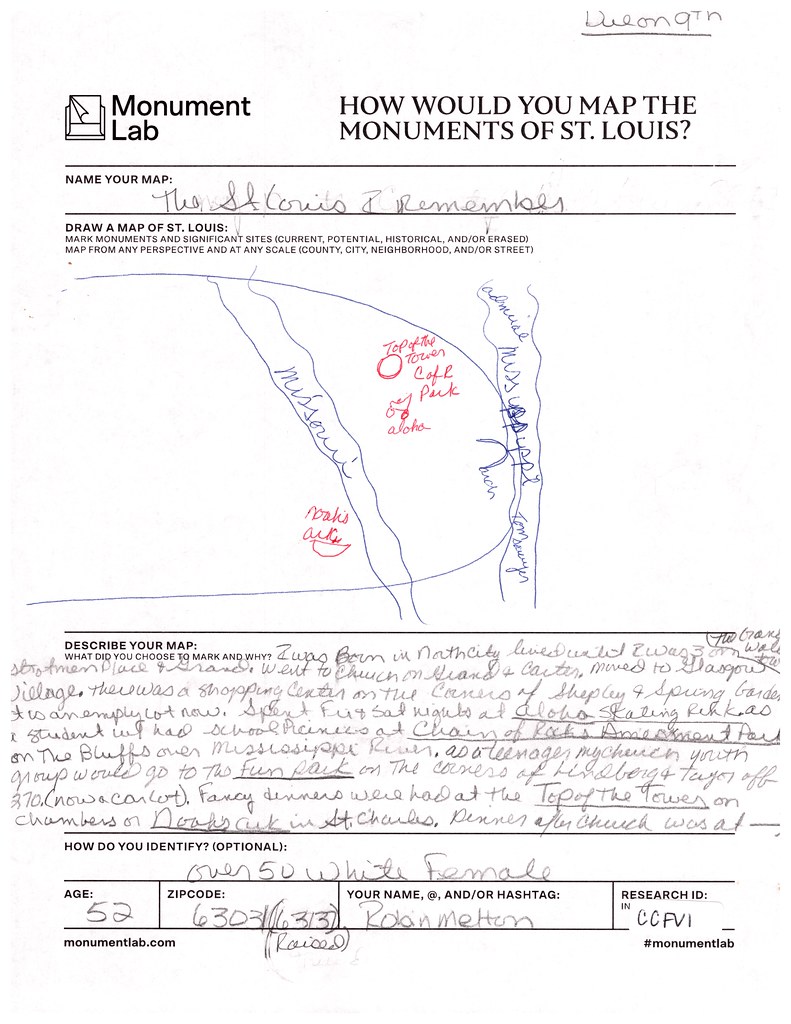Over the summer of 2019, the Pulitzer Arts Foundation and the Monument Lab team asked people about places they remember and monuments that should be erected. While the Arch was frequently mentioned and submitted in drawings of St. Louis, some submissions revealed spaces known only to people from certain neighborhoods at certain times, making them patchwork stories depicting scenes from their lives. The personal memories captured in the drawings show the myriad experiences of St. Louis residents which could be broken down by class, gender, and race.
One submission drew our attention to the SS Admiral, a steamboat that was once a floating fixture docked on the riverfront. According to the St. Louis Post Dispatch, its first excursion on the Mississippi was in 1940 and ended its cruises in 1980, while remaining open for patrons until 2001. Older generations of St. Louisans may recall the now defunct riverboat, regardless of race. Yet, in photos posted on the paper’s website, many of the images from the early days of the Admiral show white audiences enjoying their experience. It would not be until later decades that a shift toward a racially diverse clientele would be visible.

Once owned by Captain John Streckfus, Sr., and his family, the Admiral cruised the Mississippi river to attract families interested in entertainment on the St. Louis riverfront. Music scholar David Chevan explores the race-based entertainment history of Streckfus family and their steamboat business, Streckfus Steamers, which includes the Admiral. In his published article “Riverboat Music from St. Louis and the Streckfus Steamboat Line” drew from a 1967 dissertation on Streckfus Steamers to describe the racialized business practices of the company. Chevan used the marketing language of the Streckfus company to reveal its history of seeking the “very best class of people” as they “developed markets in every sector of white St. Louis society” starting in the early 20th century. Chevan suggests that the Admiral and other Streckfus Steamers were almost exclusively white until a 1969 court order forced them to integrate its audience. 1

Although the submission was of SS Admiral, a site of memory for an older white woman, it was not meant to highlight the racial lines that maintained the residential and, apparently, entertainment-based segregation of St. Louis. For her, it was a fond memory, a place she enjoyed visiting over the course of her life. Whether or not any African Americans were in the audience of the Admiral while it cruised the Mississippi River when she was onboard is unknown. What her submission does offer us is how Streckfus Steamers, a company whose name has been lost to later generations, found their intended audience by leaving its mark on her memory in such a way that her experience would one day be added to our research database. Furthermore, it allows us to think about St. Louis and its sites over time and space, reminding us that treasured memories of a golden past may obscure the tarnish of Jim Crow segregation. It shows how places in this city are remembered in different ways depending on who is telling the story.
